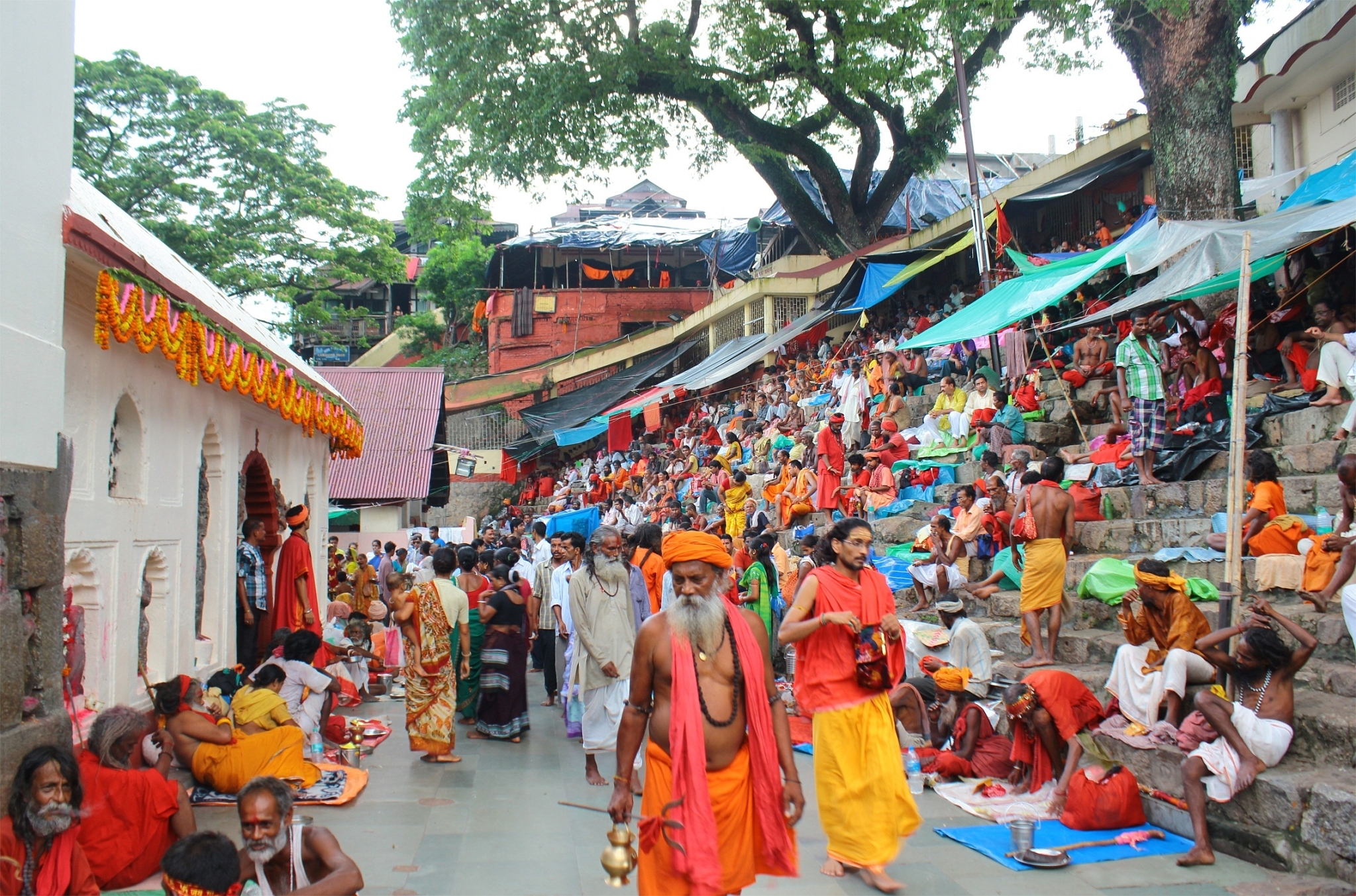Culture
Ambubachi Festival At Kamakhya: A Celebration And Worship Of Fertility
- What the Ambubachi festival at Kamakhya is, and what it is not

Devotees at the Kamakhya Mandir (Vikramjit Kakati/Wikimedia Commons)
The doors of the Kamakhya Mandir, situated atop the Nilachal Parvat on the banks of the Brahmaputra river in Assam’s capital Guwahati, have been shut to devotees for three days from today. This day marks the beginning of the annual Ambubachi festival, which ends when the temple doors will open to the lakhs of devotees gathered there on June 25 (Sunday).
More than 25 lakh devotees from all over India and neighbouring countries have congregated at Nilachal Parvat for the festival, which is often simplistically but mistakenly defined as the “celebration of Maa Kamakhya’s menstruation”. But it is not just that, the festival has a much greater significance.
Kamakhya Mandir is one of the most potent of the 51 Shakti Peeths. According to the Shiva Puran and Yogini Tantra, as well as many other Hindu religious texts, Devi Parvati went to attend a mahayagna organised by her father, Daksha. During the ceremonies, Daksha and other celestial beings started speaking ill of Bhagwan Shiva and unable to bear those insults heaped on her husband, she gave up her life.
A distraught and enraged Bhagwan Shiva picked up devi’s lifeless form and started stomping the whole earth, destroying all that came in his way. The gods then decided that Shiva had to be stopped in order to prevent the destruction of the universe. Bhagwan Vishnu deployed his sudarshan chakra to cut devi’s body into pieces, which fell on various places in the entire Indian subcontinent.
Devi’s yoni (the reproductive organ) fell on the Nilachal Parvat and the Kamakhya Mandir was constructed atop the yoni. There is no idol in this mandir; the garbha griha is a cave inside which a natural spring is worshipped as devi’s yoni. This shrine is associated with fertility and is the seat of tantra. Kamakhya Mandir was intimately associated with the many matriarchal tribes around Nilachal Parvat.
‘Ambubachi’ is derived from the Sanskrit term ambuvachi, which means “issuing forth of water”. The Ambubachi festival marks the beginning of the peak monsoon period when the rivers are in spate and the earth’s waters swell. And this ‘issuing forth of water’ is what is celebrated as the menstruation of Mother Earth. The festival happens in Kamakhya Mandir since this is where devi’s (or Mother Earth’s) yoni is seated and hence it is the focal point of this festival, which is also looked upon as a fertility festival.
Ambubachi is the celebration of the potency of Mother Earth represented and personified by the devi. Shakti and Shiva devotees hold that this is the time to celebrate the gifts of food, shelter and the very life that Mother Earth provides. “This is the time when one simply prays to the devi and celebrates her without asking for any favours from her. Throughout the year, we pray to devi for favours and her blessings. These four days, we just thank her for everything and serve her,”explained Pabindra Prasad Sarma, one of the Dolois (panel of head priests) of the temple.
Though the doors to the Kamakhya Mandir are closed to devotees for three days, the worship of devi inside the temple continues. “Some special rituals are followed and devi is offered flowers and fruits. One reason for barring devotees from entering the temple is that they may ask devi for favours and blessings, and that is not permitted during the three days,”explained Sarma.
The festival coincides with the time when Mother Earth’s fertility is increasing (with the monsoons). According to agricultural science, it is advisable to allow the earth to soak in all the water when the monsoons start before sowing. “Farmlands should, ideally, be allowed to remain undisturbed for a few days at the onset of the monsoons. Sowing after that ensures a healthy crop,” said Amarendra Saikia, a faculty member at Assam Agricultural University.
During the three days of the Ambubachi Mela, farmers also don’t sow or indulge in any other activity in their farmlands. Thus, this festival holds tremendous importance in an agrarian society that India was until not very long ago. “Like all other Hindu festivals and rituals, Ambubachi Mela also has a strong scientific basis,” said Sarma. Adherents of Shiva and Shakti cults also observe the Ambubachi festival in their homes by covering their shrines with a red cloth. Devi and Bhagwan Shiva are worshipped from behind the red curtain or the closed doors of the puja room, but nothing (favours or blessings) is asked from them. They are just thanked for the many gifts of life they have bestowed on mankind.
On the fourth day (25 June this year), the doors of Kamakhya Mandir will reopen after the yoni is given a ritualistic bath and other special ceremonies are performed. Prasad will be distributed to devotees, who also seek the prized angodak – water from the spring that is worshipped as devi’s yoni – and angovastra – the red silk cloth that covers the yoni during the period of Ambubachi.
Devi Kamakhya or Kameshwari not only signifies desire (Kamarupa, Kamarupini), but is also worshipped as the very source of human desires and also one who grants devotees what they desire. She is thus desire, as well as its fulfilment.
Image credits: Vikramjit Kakati/Wikimedia Commons
Introducing ElectionsHQ + 50 Ground Reports Project
The 2024 elections might seem easy to guess, but there are some important questions that shouldn't be missed.
Do freebies still sway voters? Do people prioritise infrastructure when voting? How will Punjab vote?
The answers to these questions provide great insights into where we, as a country, are headed in the years to come.
Swarajya is starting a project with an aim to do 50 solid ground stories and a smart commentary service on WhatsApp, a one-of-a-kind. We'd love your support during this election season.
Click below to contribute.
Latest